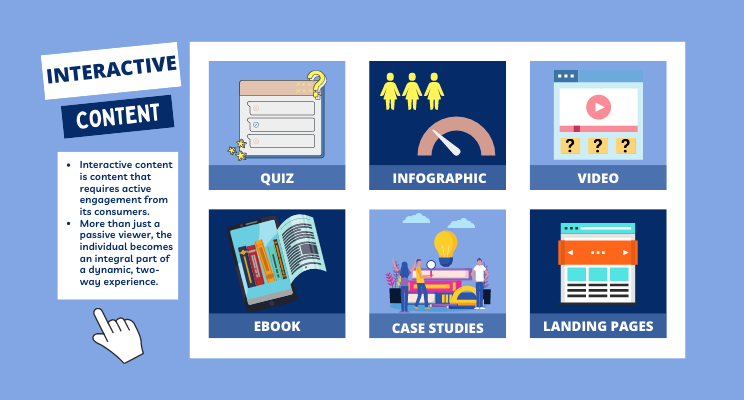Handcrafted by Users, For Users

By: Varun Tikku – WAVIT Copywriter
From Ink to Binary
Interactive content has made enormous strides since its inception in ‘The Cave of Time’, the first book in Edward Packard’s 1979 Choose Your Own Adventure series. While it’s unlikely that you remember that series, perhaps some of you recall R.L Stine’s 1995 Give Yourself Goosebumps series which followed the same formula.
The idea is that the audience makes choices throughout the story that the protagonist will perform, leading to one story being comprised of a multitude of smaller stories that can change at the whim of the reader. This not only allows the audience to interact far more with the story, but also motivates them to return to the tale to experiment with the wide variety of options available to them. Content creation is now a two-way street, where both the creators and the audience have a say in the way it is presented.
The evolution of interactive content has led it to enter the digital realm in many forms, including quizzes, landing pages, infographics and many more. Interactive content shifts the dynamics of social media consumption from passive to active, instead of passively absorbing content, consumers are actively seeking out content that appeals to them. It also shifts the dynamics between marketers and their audience, providing benefits to both. As audiences have a higher degree of agency while they choose their own content, marketers gain more traction. 81% of marketers agree that interactive content is much more effective at grabbing people’s attention than static content.
Do It Yourself
Creating interactive content can be fairly simple, you can repurpose preexisting content that has performed well and publish it in an interactive format. For example, infographics can be redesigned by reducing the amount of information displayed by default, allowing users to click over relevant sections to discover the details most pertinent to them. Ensuring that your content is compatible with different web layouts is crucial as the modern audience views content on a variety of devices, from smartphones to computers. One of the many benefits of interactive content is the vast amount of incredibly specific user data that you can collect, you can see which posts people click on, but more importantly you can see which specific parts of your content appeal to people the most which is an invaluable metric. It is imperative to collect this data to optimize your strategies for future campaigns, this will provide a variety of benefits.
4 Benefits of Creating Interactive Content
- Understand your audience
- Build your brand persona
- Optimize the selection of your campaigns
- Customize your marketing approach
The New Frontier of Interactivity
The rise of interactive content is not limited to social media, over the past couple of years it has gained traction in the world of film as well. Netflix has produced a few notable interactive films, the first is Bandersnatch (2018) which was a fatalistic take on the concept of free will, created by the twisted minds behind Black Mirror. While it was received well, the dark nature of the plot was revealed in a lot of detail during the first viewing, also many of the choices result in similar outcomes. The slow paced, serious nature of the film made going back and rewatching parts to reach the decision point a rather arduous and dull process for some, while others believed that this process helps you to empathize with the protagonist.
Kimmy Schmidt: Kimmy vs. The Reverend (2020) is another successful Netflix interactive film, which is tonally extremely different to Bandersnatch as it is a comedy. Its genre may have worked in its favour due to comedy being of a highly subjective nature, allowing the audience to choose whichever routes fit their sense of humour the best. The team behind the Kimmy Schmidt movie also had experience on their side; they learnt from Bandersnatch by allowing less variety in their ‘wrong’ choices, leading to fewer convoluted story lines. This led to viewers redoing choices more often which resulted in frustration for some but resulted in added replayability for others.
CTRLMovie released the interactive film Late Shift in cinemas earlier this year, with one key difference; you are not the only one in control of the protagonist. Everyone in the theater can vote via mobile and the choice with the most votes is performed on screen, however, this is the first time this technology has been implemented in the region so there were some teething issues with the voting system. Late Shift was originally produced as a full motion view video game in 2016, so if you prefer to be the only one making the decisions, you can always buy the game on Steam to make the decisions for yourself. This movie is an excellent example of how repurposing interactive content for another format can help you hit a wider variety of demographics with less investment required than creating new original content.
Although the technology is still in its infancy, the explosive rise in content consumption has led to a similar rise in the audience’s desire for content tailored to them. Interactive content has already permeated the world of social media and is starting to gain influence over the world of film. There is a prevalence of interactive content in gaming which works similarly to interactive film. Many of these can be repurposed with little effort as CTRLMovie has done, building upon preexisting, well received intellectual property. Everyone’s personal needs can be perfectly matched with interactive content as we are our best guides.

 Ask Us Anything!
Ask Us Anything!